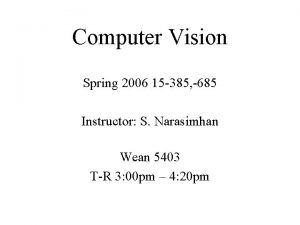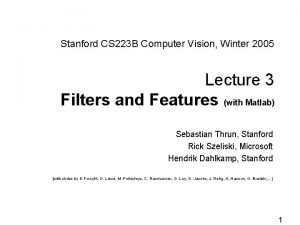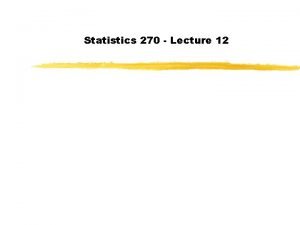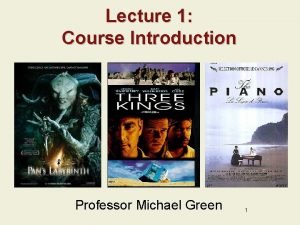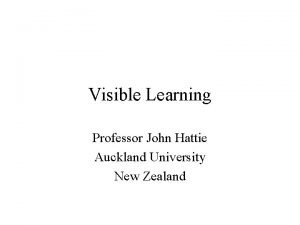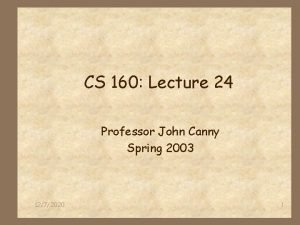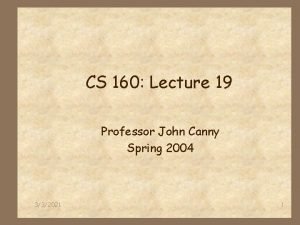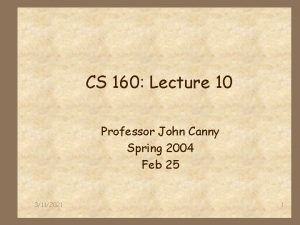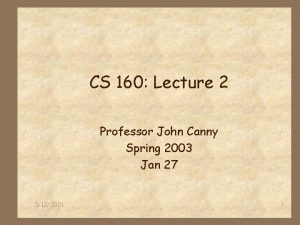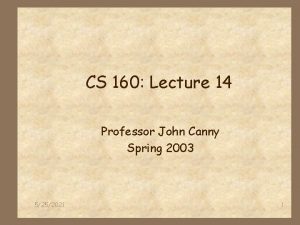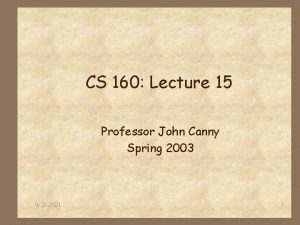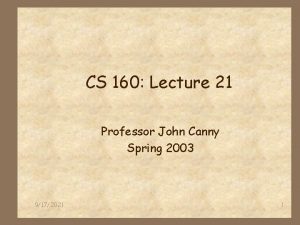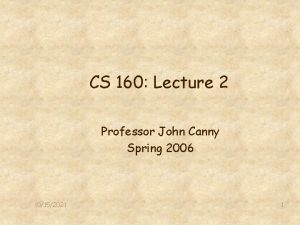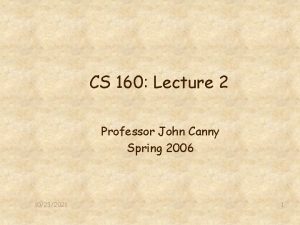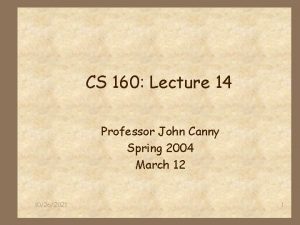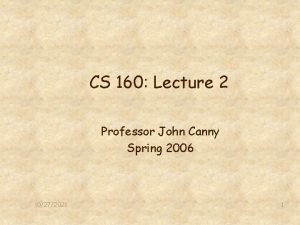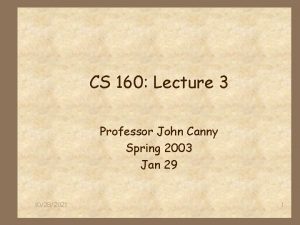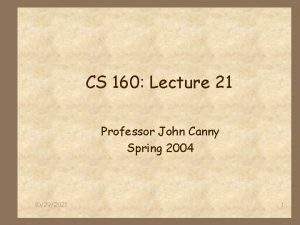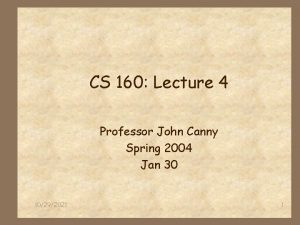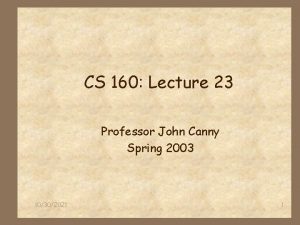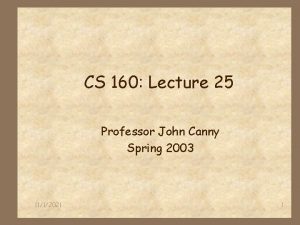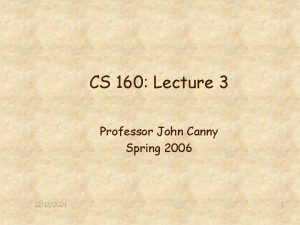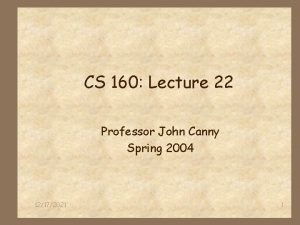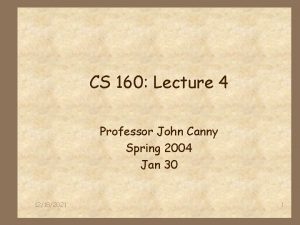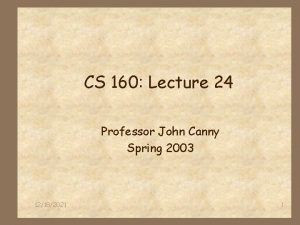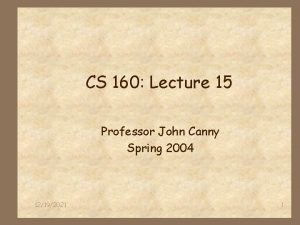CS 160 Lecture 18 Professor John Canny Spring






























- Slides: 30

CS 160: Lecture 18 Professor John Canny Spring 2004 9/25/2020 1

Social Psychology 4 Why study it? 4 It helps us understand human collaboration, which is one of the most difficult areas of HCI. 9/25/2020 2

Mere presence effects 4 Simply being near others can lead to improved performance, e. g. Triplett’s fishing observations. 4 Unfortunately, this isn’t always the case. Sometimes the opposite happens. 9/25/2020 3

Mere presence 4 Stress, anxiety or stimulation increase physiological arousal, and arousal speeds up behavior. 4 The presence of others pushes these buttons… 4 But increased speed can also increase errors, so it can be bad on difficult tasks. 9/25/2020 4

Mere presence 4 Increased arousal generally helps learning 4 But, it also heightens response to well- learned stimulae (Zajonic and Sales): It says “alpha helix” 9/25/2020 5

Mere presence 4 Mere presence isn’t quite the right idea. 4 The presence of a blindfolded subject didn’t increase arousal, and didn’t affect performance. 4 The presence of others evaluating or competing with us is what matters. 9/25/2020 6

Mere presence – Design Implications 4 Increasing the level of group “awareness” should increase mere presence effects: * * Heightened arousal Faster performance Increased learning More errors 4 Examples: * High awareness – video conferencing, phone * Medium – Instant messaging * Low awareness – Email 9/25/2020 7

Attribution 4 How do we attach meaning to other’s behavior, or our own? This is called attribution. 4 E. g. is someone angry because something bad happened, or because they are hot-tempered? 9/25/2020 8

Attribution: ourselves 4 Lets start with ourselves, how good are we at figuring out our emotions? 4 Schacter: it depends strongly environmental and physiological factors, and others near us. 4 The bottom line is that we can feel strong emotion, but struggle to recognize it as happiness or anger. 9/25/2020 9

Attribution theory 4 Attribution theory: was this behavior caused by personality, or environment? 4 Fundamental attribution error: * When I explain my own behavior, I rely on external explanations. * When I explain others’ behavior, I’m more likely to attribute it to personality and disposition. * e. g. other drivers are either “lunatics” (faster than me) or “losers” (slower than me). Of course, they have the same model about you… 9/25/2020 10

Attribution theory – design implications 4 To reduce attribution errors, its important to have as much context as possible. 4 E. g. room-scale video-conferencing, or ambient displays: 9/25/2020 11

Social Comparison 4 We need to make comparisons to make judgements about people. Three rules: * Limitation: qualities must be observable and comparable to be attributed. * Organization: we use categories to describe and think about people; friendly, studious, careless etc. * Meaning: categories of personality must make sense, e. g. friendly and cooperative go together, friendly and hostile do not. 9/25/2020 12

Groups 4 Groups are a strong influence on our behavior. 4 A “reference” group is one we share a psychological connection with, e. g. a club or honor society we aspire to join. 4 We compare our selves to reference groups to make self-assessments. 9/25/2020 13

Groups 4 Groups give us value in several ways: 4 They provide us norms for behavior (informational function) 4 They satisfy interpersonal needs (interpersonal function) 4 They provide us with concrete support, resources, help (material function) 9/25/2020 14

Groups and Motivation 4 Groups increase motivation in two ways 4 First, the social interaction with the group intensifies individual motivation, and sometimes generates new individual motives. 4 Second, the group can cause group goals and motives to be created. E. g. group maintenance is goal most groups have. 9/25/2020 15

Group goals 4 Goals can be either short-term or long-term. 4 Long-term goals are harder to manage and maintain and generally have less effect on group behavior. 4 Short-term goals are strong force in motivating and reinforcing group performance. 9/25/2020 16

Group goals 4 The composition of the group can strongly affect its goals. 4 E. g. a group united by profession will tend to adopt goals related to the profession’s methods. 4 Groups often have subgroups that wield influence over the main group. They need not be majorities. 9/25/2020 17

Group experiences 4 Previous experience affects goal-setting. 4 Groups that have succeeded are more likely to raise goals, groups that have failed are unlikely to lower them. 9/25/2020 18

Group experiences – design implications 4 Normative data can be very helpful – how am I doing compared to a typical colleague? * Compute normative data automatically 4 Set short-term goals, mark off successes – challenge to do this efficiently * PERT charts or Calendars * Daily software builds * Extreme programming 9/25/2020 19

Summary 4 Mere presence influences speed of performance, through evaluation and competition. 4 Attributions of behavior causes have an actor-observer effect. 4 Social comparison is how we make judgements. 4 Groups influence our perception of self and others through norms (reference groups). 4 Groups influence behavior as well. 9/25/2020 20

Break 9/25/2020 21

Livenotes: Collaborative in-class notetaking 4 Small-group learning in large classes 4 Uses pen tablets to allow students to mark up Powerpoint slides and communicate in small groups (4 -7 optimal) 9/25/2020 22

Livenotes: Motivation 4 Peer instruction is a potent facilitator of classroom learning * It is helpful for students to explain material to one other 4 Attention is a critical resource in classrooms * A student’s attention is enhanced through interaction with his or her peers 4 Learning takes place better in small groups * Promotes academic achievement, attitudes towards learning and student persistence 4 Can we foster small-group learning in large classrooms? 9/25/2020 23

Background: TVI and DTVI 4 The TVI (Tutored Video Instruction) method was developed at Stanford. * A video recording is made of the lecture. * Students review the recording in a small group (4 -7 students) with a tutor. * Students pause the replay, and discuss with each other. * There is a lot of interaction: 50% of students participate in 50% or more of the discussions. 9/25/2020 24

Background: TVI and DTVI 4 DTVI is Distributed TVI. The lecture is webcast, and student interact with each other and the tutor using videoconferencing. 9/25/2020 25

TVI/DTVI studies 4 There have been many studies of TVI/DTVI. 4 One of the largest was a study of DTVI with Sun Microsystems. The results were remarkable: * Students using DTVI received grades 0. 2 to 0. 8 std. deviations higher than students taking the same class live. 4 Group interaction by itself is a facilitator of learning (independent of salience). 9/25/2020 26

Live. Notes Hardware 4 Live. Notes is a multithreaded C# program that runs on pen-based computers (Tablet-PCs) over wireless TCP/IP networks. 4 Tablet PCs received through MS’ RFP process. 9/25/2020 27

Live. Notes Overview 4 Live. Notes is used in small groups of students (5 -7). 4 Students start with skeletal lecture notes, or one member acts as scribe. 4 Other members add their comments and notes to the shared transcript. 9/25/2020 28

Laptop example 9/25/2020 29

Livenotes study 4 We plan to do a Livenotes study in this class, starting soon (probably next week). 9/25/2020 30
 Imagem de uma rampa fonte max pixel
Imagem de uma rampa fonte max pixel What is canny edge detection in image processing
What is canny edge detection in image processing Traitement dimage
Traitement dimage Canny
Canny Joe canny
Joe canny Canny
Canny Canny
Canny Canny sebastian
Canny sebastian Canny mask
Canny mask Promotion from associate professor to professor
Promotion from associate professor to professor A college professor never finishes his lecture
A college professor never finishes his lecture Professor green lecture 1
Professor green lecture 1 01:640:244 lecture notes - lecture 15: plat, idah, farad
01:640:244 lecture notes - lecture 15: plat, idah, farad Spring, summer, fall, winter... and spring cast
Spring, summer, fall, winter... and spring cast Months in fall
Months in fall Professor john forsythe
Professor john forsythe Professor john forsythe
Professor john forsythe Professor john wood
Professor john wood Self-directed search
Self-directed search Professor john hattie
Professor john hattie Professor john hughes
Professor john hughes John stanley temple
John stanley temple Yzde
Yzde Smt 160
Smt 160 12vac35-105-620
12vac35-105-620 Wac 296-800-160
Wac 296-800-160 Patrick liang
Patrick liang Konica minolta bizhub 160
Konica minolta bizhub 160 Parafrasi il canto delle sirene dal verso 160
Parafrasi il canto delle sirene dal verso 160 Data domain 640
Data domain 640 40 cfr 160
40 cfr 160






